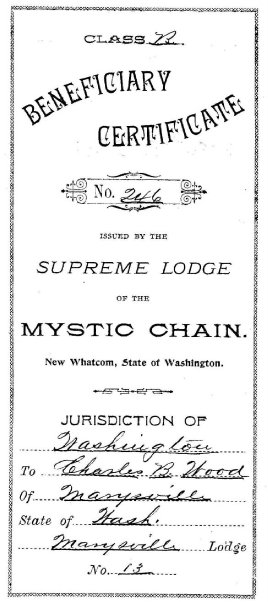En:Knights of the Mystic Chain
Ancient Order Knights of the Mystic Chain

Courtesy: Phoenixmasonry
Almost certainly a splinter group of the Knights of Pythias—21 of the founding members were Pythians. There are numerous other similarities. Like the Pythians, they called their lodges Castles and the MC Degrees of Esquire, Sir Knight, and Knight of the Round Table closely resemble the Pythian ranks of Page, Esquire, and Knight.
Their name has a Masonic connection. In Masonry the Mystic Chain is the formation of the Brethren in a circle, holding each other by the hands. Each brother crosses his arms in front of his body, giving his right hand to his left hand neighbor and his left hand to his right hand neighbor. It is a symbol of the close connection of all Masons in a common brotherhood, and is usually practiced around the grave in Masonic Burials.
The AOKMC was founded in Reading, Pennsylvania in 1870. Though it seems to have been quite popular in PA, it doesn’t seem to have made much headway outside of that state—it is not listed among the top forty fraternal orders in the world almanac of 1896 and probably had no more than 10,000-15,000 members at its peak. Like most small orders, it did not survive the Great Depression of the 1930’s. Virtually all jewels, medals, and pins from this order seem to be found in Pennsylvania.
It added a Military Rank in 1880 (the Pythian Uniformed Rank arrived in 1878) and the Degree of Naomi (or Daughters of Ruth) arrived in 1890 (Pythian Sisters in 1888). Like the Pythians, the MC was not founded as a Fraternal Benefits Society and did not offer its members insurance until 1889.
The Mark or Past Commander’s Degree (blue ribbon) was given to past officers and made them eligible to sit in the Select (State) Lodge. There was also a Supreme Lodge though this seems a bit ambitious for an order that seems hardly to have made it outside the state of Pennsylvania. The red-ribboned piece is from the Military Rank. The Member’s jewel is silver plated brass and the gold fill and enamel work on the Commander’s jewel is not of the highest quality suggesting—again like the Pythians—that this was a working class order without a lot of money. The pentagon motif so dear to the Pythians has been preserved in these jewels.
Though the Pythian influences are overwhelmingly evident, It is difficult to determine the exact relationship of these two orders. At the time of the MC founding, the Pythian Grand Lodge of Pennsylvania was in full-blown revolt against the Pythian Supreme Lodge. The battle had been raging in one form or another since Rathbone had founded the order in 1864 and especially since he had tried to add a fourth degree. The AOKMC is possibly related to Rathbone’s Order of Supreme Pythian Knighthood which got him expelled from the KoP. Pennsylvania was certainly a hotbed of SPK activity. See the Knights of Pythias page for a history of that order.
Now here’s a mystery. In 1895 there existed in New Whatcom, Washington, something called the Supreme Lodge of the Mystic Chain. The insurance policy shown was issued by them to a member of a subordinate lodge (#13) just down the road in Marysville. New Whatcom is better known these days as Bellingham and is located 90 miles North of Seattle. It is the County Seat of Whatcom County.
Is this somehow connected with the AOKMC? Hard to say. Axelrod notes that the AOKMC did have a Supreme Lodge. But it seems most unlikely that they would establish their national headquarters all the way across the country from their place of founding. This is especially true since the AOKMC was almost exclusively a Pennsylvania organization. Aside from some farming and logging, there really wasn’t much happening in the Pacific Northwest in 1895.
So just what was the Supreme Lodge of the Mystic Chain of Washington State? It appears to have functioned at least as a Grand Lodge with at least thirteen subordinate lodges under it. (A Grand Lodge is a State governing body, as a rule.) Just whether it had any connection—other than a common name—with the AOKMC is debatable. (The term “AOKMC” does not appear on the insurance policy.) It most likely was a separate organization—quite possibly founded by a member of the AOKMC.
People were moving west in the late 1800’s. The railroad had been completed and the Alaskan gold rush made Seattle a provisioning point for those on the way to find their fortune in Alaska. One of the traditions the easterners would have brought with them was the fraternal lodge and fraternal benefit societies. Washington State had a strong and early tradition of fraternal orders with the Odd Fellows being especially well established. It would have been fertile ground for new orders, especially those offering affordable life insurance.
Both the Ancient Order Knights of the Mystic Chain and the Supreme Lodge of the Mystic Chain are long since defunct. The National Fraternal Congress of America’s listing of name and status changes of fraternal benefit societies does not mention either of them. This mystery may have to remain unsolved.
"In early 2006, the Phoenixmasonry site received an email from an AOKMC member informing us that there was one lodge remaining, Castle # 23 in Vera Cruz, Pennsylvania. It is not known if this Castle is still active."
See also

